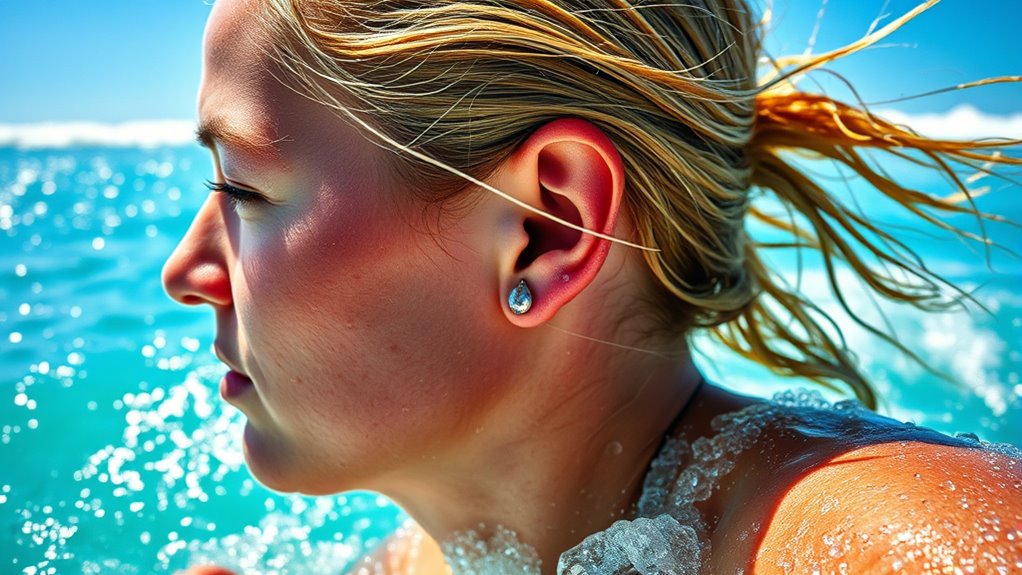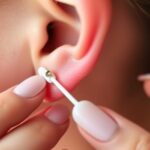When heading into the ocean with fresh piercings, you should protect your jewelry by covering the area with waterproof bandages or sealants to prevent saltwater contact. Minimize exposure by rinsing your piercing with fresh water immediately after swimming, and avoid submerging it fully until healed. Keep the area clean and dry, and follow your piercer’s advice on managing your piercing in saltwater. Curiously, there’s more you can do to keep your healing smooth—discover how further!
Key Takeaways
- Cover the piercing with a waterproof bandage before entering saltwater to prevent direct contact.
- Minimize submersion and avoid exposing the fresh piercing to saltwater during healing.
- Rinse the piercing with fresh water immediately after ocean exposure to remove salt and debris.
- Gently pat the area dry and avoid touching or irritating the piercing afterward.
- Follow your piercer’s advice on when and how to safely reintroduce saltwater exposure.

If you’re considering getting an ocean piercing, it’s vital to understand how saltwater can affect your new jewelry. Saltwater, while natural and abundant in the ocean, can pose challenges for your piercing during the healing process. It’s tempting to jump into the surf right away, but exposing your fresh piercing to saltwater too soon can lead to complications like infections or irritation. To protect your investment and guarantee proper healing, you need to take specific precautions. Regular jewelry cleaning is essential, especially after ocean outings. Rinsing your piercing with fresh water after swimming helps remove salt, sand, and other debris that can irritate the tissue or introduce bacteria. Gently drying the area afterward prevents moisture buildup, which can hinder healing and cause bacteria to thrive.
During the healing process, it’s best to avoid soaking your piercing in saltwater directly, such as swimming in the ocean or using saltwater rinses without guidance from your piercer. Saltwater can be beneficial in small amounts, but excess exposure can dry out your skin and delay healing, especially if the jewelry isn’t properly cleaned or if the piercing isn’t fully healed. You should follow your piercer’s advice on how long to wait before immersing the piercing in saltwater, as every body heals differently. Until then, stick to gentle cleaning routines with sterile saline solutions or recommended cleaning agents to keep the area free of bacteria and debris.
Additionally, understanding the healing process can help you better manage your expectations and care routines during recovery. If you do decide to go into the ocean during the healing phase, take steps to protect your piercing. Cover it with a waterproof bandage or avoid submerging it altogether. If saltwater does contact your fresh piercing, rinse it immediately with fresh, clean water and pat dry with a soft cloth. This prevents salt buildup that could cause irritation or prolong the healing process. Remember, your body needs time to heal, and saltwater exposure during this delicate phase can interfere with that process. Be vigilant about signs of infection, such as unusual redness, swelling, or discharge, and seek medical advice if needed.
Frequently Asked Questions
How Long Should I Wait Before Surfing With a New Piercing?
You should wait at least 6-8 weeks before surfing with a new piercing. Healing timelines vary, but it’s essential to follow water exposure guidelines to prevent infections. During this time, keep your piercing clean and avoid submerging it in saltwater or chlorinated water. Once fully healed, you can surf safely, but always listen to your body and consult your piercer if you notice any issues.
Are There Specific Types of Jewelry Better for Saltwater Exposure?
When choosing jewelry for saltwater exposure, you should look for saltwater safe options. Jewelry materials like surgical steel, titanium, or niobium are ideal because they resist corrosion and won’t irritate your piercing. Avoid non-sterile or porous materials like cheap plastics or certain alloys. These saltwater safe options help protect your piercing from damage and infection, ensuring it stays healthy while enjoying ocean activities.
Can Saltwater Cause Infections in Fresh Piercings?
Imagine you’re a sailor steering treacherous waters—saltwater concerns can lead to infection if you ignore proper care. Yes, saltwater can cause infections in fresh piercings by introducing bacteria. To prevent this, you should practice infection prevention by avoiding swimming in saltwater until your piercing heals and keeping the area clean. Protect your healing process, just like a sailor shields their ship from stormy seas, to guarantee your piercing heals smoothly.
What Are Signs My Piercing Is Irritated From Saltwater?
You might notice signs of irritation from saltwater sensitivity, such as redness, swelling, or soreness around your piercing. If you see increased pain, discharge, or crusting, your skin could be reacting negatively. These signs indicate your body’s irritation from saltwater. To protect your fresh piercing, avoid exposing it to saltwater until it heals completely, and keep an eye on any adverse reactions to prevent infection or further complications.
How Can I Clean My Piercing After Ocean Swimming?
Think of your piercing as a delicate garden needing gentle care. After ocean swimming, rinse it with sterile saline solution, like watering tender plants. Use jewelry materials suitable for healing, such as surgical steel or titanium, to avoid irritation. Stick to your healing timeline, cleaning twice daily, and avoid harsh chemicals. This routine keeps your piercing healthy, letting it flourish into a beautiful, resilient bloom.
Conclusion
So, next time you hit the waves, remember your piercings are like treasures in a tide pool — delicate yet resilient. With proper care, you can enjoy saltwater adventures without risking your fresh piercings. Think of saltwater as both a friend and foe, but your vigilance keeps the balance. Protect your piercing, and let the ocean be a playground, not a peril. After all, isn’t it worth safeguarding your sparkle amidst the endless blue?
















